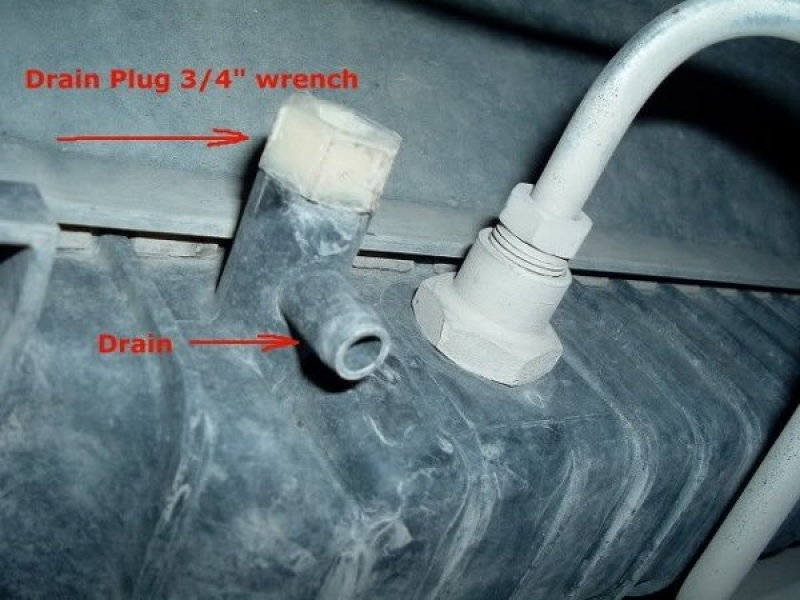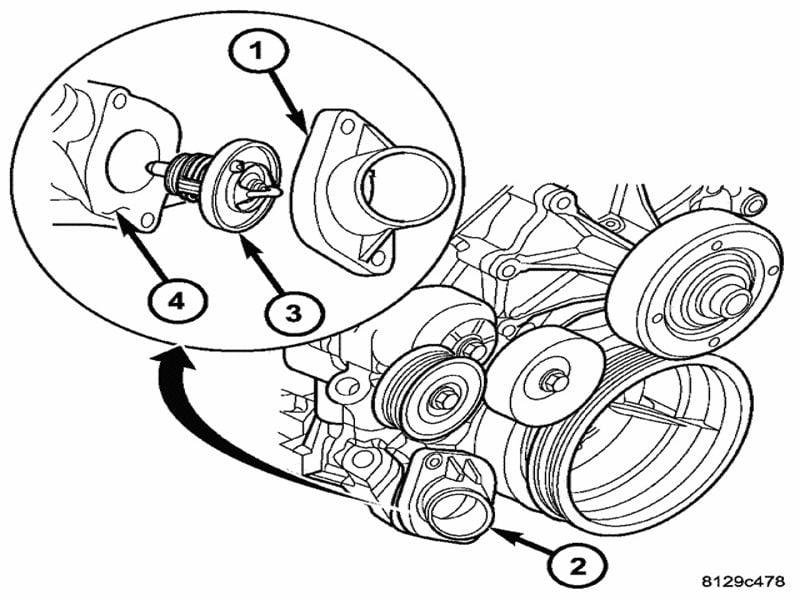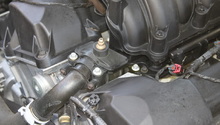Dodge Ram 2002-2008: How to Replace Thermostat
The thermostat blocks the coolant from flowing into the radiator as the engine is warming. A fault with the thermostat can cause reduced engine performance and overheating, typically seen on the instrument gauge panel.
This article applies to the Dodge Ram 3rd Generation (2002-2008).
Thermostats regulate engine temperature by opening and closing the passage to the radiator. When the engine is first started, it needs to warm as fast as possible. Keeping coolant from reaching the radiator speeds up this process, reducing wear and emissions. Thermostats use both seals and springs to move as well as block coolant flow. No electronics are used to make the thermostat operate. Instead, a wax pellet that melts when the coolant reaches a certain temperature draws the thermostat closed.
Thermostats can become stuck open or closed. A stuck closed thermostat will cause the engine to run cooler than normal, while a stuck open thermostat can cause the engine to overheat very quickly.

Materials Needed
- Socket set (10mm-18mm)
- Ratchet (1/2" or 3/8")
- 3" ratchet extension
- Flat head screwdriver
- Thermostat
- 3-4 gallons of coolant (buy HOAT (Mopar) coolant for trucks with it already installed)
- Drain pan
- 3/4" wrench
The location of the thermostat for the 5.7 Hemi engine and the 4.7/3.7 engines are different. On the Hemi, the thermostat is located on the engine at the upper radiator hose below the A/C compressor. The 4/7 and 3.7 engine's thermostat is located on the lower radiator hose near the harmonic balancer.
Step 1 – Drain the coolant from the radiator
Remove the radiator cap by pushing it down, and then twisting it counterclockwise.
At the driver's side bottom corner of the radiator is a drain blocked by a plug. Turn this plug counterclockwise with a 3/4" wrench after you place a drain pan beneath it.

Step 2 – Remove the thermostat
To reach the thermostat, you must remove the hose neck from the engine. Two bolts hold it in place. Once it's removed, the thermostat will slide out.

Figure 2. The red circle indicates the position of the hose filler neck on the 5.7 engine. 
Figure 3. A diagram of the 5.7 thermostat. Number 1 indicates the hose filler neck bolts. Number 2 indicates the filler neck. 
Figure 4. The thermostat location on the 4.7 and 3.7 engines. You can see the harmonic balancer at the lower right side of the image. 
Figure 5. A diagram of the thermostat on the 4.7 and 3.7 engines.
Step 3 – Install the new thermostat
Some thermostats come with an air bleed valve and notch at the edge of the diaphragm. The notch must be filed into the new thermostat to look like the factory thermostat for proper fitment with the O-ring. The bleed valve is not required; although, it does make bleeding the cooling system of air easier. Transfer any gaskets from the original thermostat not found on the new thermostat if they are in good condition; otherwise, you will need to buy new ones. Make sure they are orientated correctly for proper fitment into the block and hose filler neck. The spring side of the thermostat will be facing the engine.
Bolt the hose filler neck back onto the engine with the thermostat correctly placed inside.

Figure 6. You can see the bleed valve on the face of the original thermostat on the left. Both thermostats have the notch on the edge. 
Figure 7. The red arrow points to the slot in the hose filler neck that fits to the thermostat O-ring.
Step 4 – Fill and bleed the cooling system
You will need about three gallons of 50/50 mixed coolant to fill the cooling system. For trucks using HOAT coolant, be sure to use the same type. For the 4.7 and 3.7 engines, remove the upper radiator hose and fill the engine with as much coolant as possible.
The rest of the instructions apply to all engines. Fill the radiator, and then fill the coolant recovery tank to the cold full mark. Leave only the recovery tank's cap off. Now start the engine and turn the heat to the max setting. It will take several minutes for the cooling system to warm and move air through the system. Once the temperature gauge reaches about 1/4 of the way to the half mark, shut the engine off. Top off the coolant in the recovery tank as needed during this procedure. Put the recovery tank cap back on and start the engine again. If the temp gauge rises above halfway, you may still have air in the system and will need to repeat the bleeding procedure once the engine is cool enough to do so.
Related Discussions
- Thermostat Install DIY - DodgeForum.com
- Where is the Thermostat - DodgeForum.com
- Thermostat Placement on Ram 1500 - DodgeForum.com






